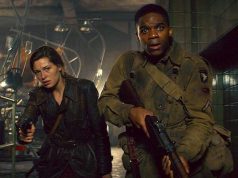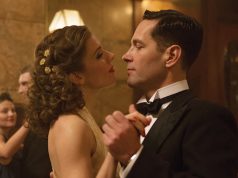The technical aspects of Steven Soderbergh’s “The Good German” have come to outweigh its actual content in most discussions of the film. Could it be that the way the movie was made is more interesting than the movie itself? We shall see.
For film geeks, it offers much to contemplate. Soderbergh sought to make it look as though it had been produced in the 1940s, and, not content to just shoot it in black-and-white, he also only used the camera lenses and sound-recording techniques that were available at the time. In addition, he reportedly instructed his actors to perform in the presentational, slightly melodramatic manner that was typical of Old Hollywood, and they had to enunciate and project their voices, too, as no wireless body microphones were used, just old-school boom mics.
All of which makes for an intriguing experiment, made more so by Soderbergh’s inclusion of some things that a film made in the ’40s certainly would NOT have had: profanity, sex, nudity, and violence. Why go to all that trouble to duplicate the Hollywood of yesteryear only to shatter the illusion with jarring reminders that the movie is, in fact, a product of modern times? Obviously it was a conscious decision, and the story could have been told without those elements, just as its 1940s predecessors were. What was Soderbergh’s point? Did he want to make an “old” movie but without the restrictions placed upon the actual old movies? Isn’t that a little self-indulgent?
Most experimental films are a little self-indulgent, though; you often get the sense that the movie is being made for the amusement of the filmmakers, unconcerned about whether anyone else will like it. “The Good German” feels that way to some extent — here’s Soderbergh, cavorting with his buddy George Clooney again — but not so much that the film is rendered useless. You can ignore the behind-the-scenes technicalities and enjoy the movie on face value: as a moderately entertaining nod to “Casablanca” and “The Third Man.”
Clooney plays Capt. Jake Geismer, a military journalist sent to Berlin in 1945 to cover the Potsdam Conference. He worked at the Associated Press bureau there before the war and has a lost love lurking around somewhere. She is Lena (Cate Blanchett), a gorgeous, smoky German who now works as a prostitute to stay alive and who has latched on to a U.S. Army soldier named Patrick Tully (Tobey Maguire) in the hopes that he can get her out of the country. Tully, for his part, is a conniving schemer who, coincidentally, has been assigned as Geismer’s driver while he’s in Berlin.
Then there is a murder, and while the local authorities aren’t particularly concerned about it — they have bigger things to worry about, what with Truman, Stalin, and Churchill arriving for the conference — Geismer takes it upon himself to find the culprit. Why he cares who killed this person is not clear, though we do know his attachment to Lena motivates him to do a lot of work on her behalf, including looking for a mysterious man named Emil Brandt who seems to be at the top of a lot of people’s “must find” list.
Adapted from Joseph Kanon’s novel by Paul Attanasio (“Quiz Show,” “Donnie Brasco”), the screenplay manages the neat trick of changing narrators a couple times, but it can’t quite maintain its momentum for the duration of the film. Eventually you’re watching out of complacency, not because the machinations of the plot continue to hold your interest.
Clooney may get beat up a lot like Bogart used to, but Geisler can’t hold a candle to the reluctant heroes Bogey played. It feels too much like a game to Clooney, an acting exercise you do in an improv class. (“You’re the hero in a post-war film noir! Aaaaand … GO!”) The enchanting Cate Blanchett makes for a pretty good reincarnation of Marlene Dietrich, though, and Tobey Maguire holds his own as the requisite weaselly third character. (There’s always a weaselly third character.)
Yet I found the film fascinating to watch even when the story had lost its zip. Why? Because I’m a film geek, and I think it’s nifty to see modern filmmakers replicate old styles. That’s enough to sustain me, though of course your own mileage may vary.
B (1 hr., 45 min.; )





